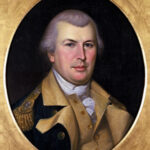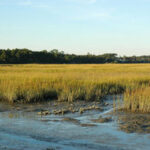Francis Marion’s men often out numbered and ill equipped, would fight from behind trees and bushes. They would hit quickly and run to live and fight another day. Knowing that his troops were over matched in many cases, Marion would employ guerrilla tactics to attack the British Regulars.
He was born in Georgetown, South Carolina in 1732. The youngest in a family of six was even considered “puny” as he was born. Many joked that he was not much bigger than a lobster. Little did anyone know that this lobster would revolutionize warfare tactics during the Revolutionary War.
At the age of fifteen, he begged his parents to let him become a sailor. In an effort to shape up his body, his parents agreed. He signed on as a sixth crewman with a schooner headed into the West Indies. His ship was rammed and sunk by a whale. Marion survived for two days in the open sea before landing on an island. The experience made him a stronger individual. Although he never returned to sailing again.
In 1757 he joined the army and fought in the French and Indian Wars. Under orders from Colonel James Grant, Marion was ordered to burn down the Cherokee’s homes as well as destroy their crops in the field. Although he thought this was a very poor idea at the time, he followed the orders given to him.
In 1775, he was a member of the South Carolina Provincial Congress. He was commissioned Captain of the second South Carolina Regiment. He helped defend Fort Sullivan and Fort Moultrie in Charleston harbor in 1776. Also that year, the Continental Congress made a lieutenant-colonel. After the fall of Charleston and the defeats of General Huger and lieutenant-colonel Buford at the Waxhaw massacre, Marion was the only military leader left in the state to fight the British. To make matters worst, he only had between 20 to 70 men. He took what few men he had and joined General Horatio Gates. Gates having no confidence in Marion, just sent him to take command of the Williamsburg Militia.
It was during this time that Marion made his mark as great leader of irregulars. His troops would continually hit and run, disrupt communications, and frustrate the British troops. His troops became so good, that the British sent Colonel Banastre Tarleton after him. Tarleton was known for being ruthless and giving no quarter. Marion’s guerrilla warfare infuriated Tarleton so much, that he gave Marion the name of “The Swamp Fox.”
Marion was commissioned to the post of Brigadier- General by Governor John Rutledge. Marion worked with General Nathan Greene to win many important battles in the South. On August 31, 1781, Marion defeated an army of 500 British regulars under the leadership of British Major C. Fraser. During this battle, he rescued many American prisoners.
With the war coming to a close, he retired in August of 1782 and returned to his plantation. He married Mary Ester Videau, a cousin. He served several terms in the South Carolina Senate. In 1784 he was made commander of Fort Johnson. This was just a courtesy title for his contribution to the state of South Carolina. It is said that Marion a slave owner, had over 200 slaves on his plantation. He died on his estate in 1795 at the age of 63. He is buried at Belle Island Plantation Cemetery in South Carolina. His tombstone notes that besides being a noble citizen, that he was a Patriot and hero of the Revolutionary War. He lived without fear and died without reproach.
Francis Marion the father of modern guerrilla warfare. Better known as the “Swamp Fox.”


